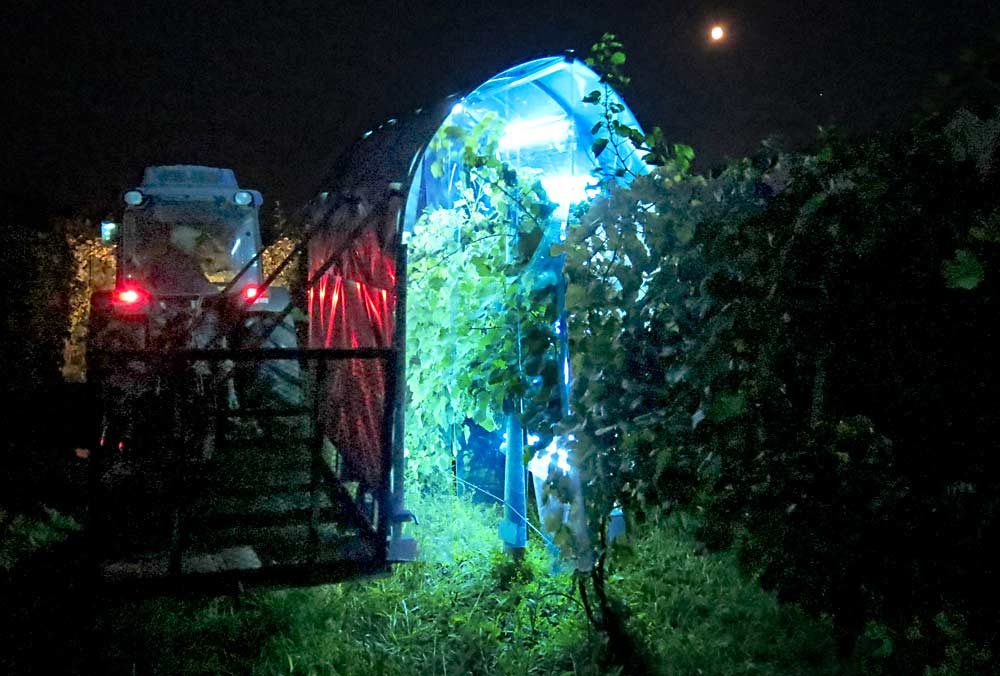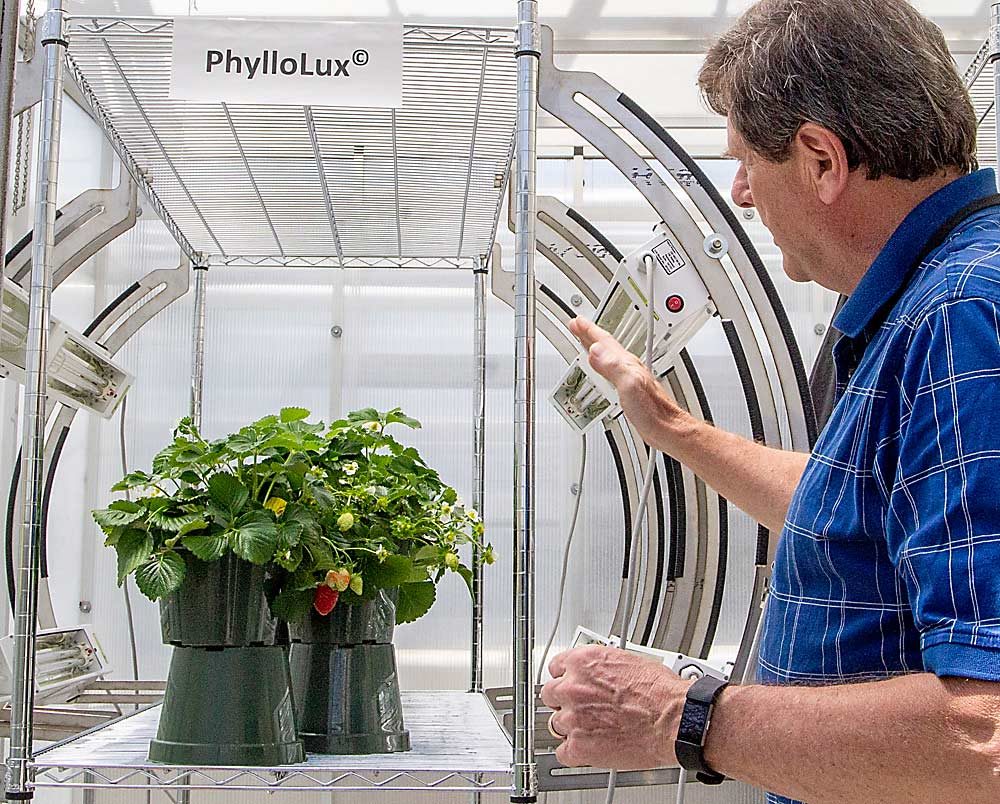
It glows in the dark like a UFO.
But it’s not an alien spaceship sneaking through a Cornell University vineyard in the dark of night. It’s a trial, using ultraviolet light to kill powdery mildew, with germicidal lamps and reflectors rigged up to briefly shine the DNA-disrupting light on every surface in the canopy as the lights are pulled down the row by a tractor.
It’s basically a light sprayer.
And the technology shows promise for controlling powdery mildew on wine grapes, strawberries, hops and vegetables, according to David Gadoury, a Cornell University grape pathologist who has been testing the best way to deliver UV light for fungal disease control.
The idea dates back decades, but early research hit a major roadblock: Using enough UV light to kill pathogens also damaged their host plants. Everything changed when researchers tried applying the light at night.

“People don’t really think of fungi as being responsive to light, but they are, like plants, and they see it and use it to control their development,” Gadoury said. During the day, fungi and plants sense light and turn on systems to repair DNA damage from UV light, but at night, those mechanisms shut down, creating an opportunity.
“At night, the plant’s defenses are down, too, but you can use a much smaller dose to kill the pathogen,” he said. “A single-celled organism on the surface of the leaf, it’s pretty easy to kill.”
The shortwave UV prevents DNA from replicating, so it stops the powdery mildew from germinating new spores. The dose needed depends on the intensity of the light and the exposure time, Gadoury said.
Over the past three years, the research team from Rensselaer Polytechnic Institute’s Lighting Research Center, the Norwegian University of Life Sciences, the University of Florida and Cornell AgriTech have made a lot of progress figuring out how best to deliver the effective amounts of light to different crops. The project is supported by $10 million in grant funding from the U.S. Department of Agriculture, the research institutions involved, and a commercial vineyard in New York’s Finger Lakes region.
Another team of researchers at the USDA’s Appalachian Fruit Research Station in West Virginia has also been working on UV light applications for strawberries, where it’s been shown to control powdery mildew, gray mold and spider mites (see “Strawberry system combines UV with biocontrols” at the end of this story).
USDA pathologist Wojciech Janisiewicz said research into UV has taken off in recent years, since the discovery that “it’s so much easier to kill them if you keep them in the dark for two to four hours,” depending on the pathogen.
“It’s a matter of when, not if, the technology will be commercially available,” he said, referring to both the strawberry system he and his colleagues developed, as well as applications by other research groups in other commodities.
Vineyard glow
Gadoury’s vineyard setup uses an array of 75 to 100 lamps — glass tubes similar to fluorescent lamps but without the coating that household lamps use to shift the wavelength into the safe zone — combined with reflectors, inside a shield that carries the lamps over the canopy.
“It’s not a death ray, but it will give you the mother of all sunburns, and if you look directly at it, it could blind you,” Gadoury said, adding that the vineyard array is designed to prevent worker exposure to UV with shields, so only the glow is visible. “When you see these things going through the vineyard at night, glowing in the dark, it’s sort of otherworldly.”
Inside the array, there are enough reflectors to create a fog of light particles that bounce around and hit every canopy surface. Engineers at the Lighting Research Center have worked on how to optimize that light spray and how to size it for delivery, Gadoury said.
If you want to pull an array behind a tractor at 2 miles an hour, you have to make it long enough and bright enough to get sufficient exposure at that rate. A robot array that crawls through a strawberry field, on the other hand, can be much smaller, since it also moves much slower.
The research team offers seminars on the design of the equipment needed to meet a crop’s needs. That’s unusual for an emerging agricultural technology, but Gadoury explained that the basic idea is not patentable, because patents that were filed decades ago have already expired.
Instead, “the grant budgets are really dedicated to providing hardware and expertise to people,” he said. “We’ll make the technology freely available, but we’re not in the business of commercializing.”
He hopes a company will take up the idea and build commercial arrays, but until then, the team of researchers provides hardware, electronics and calibrations to interested people at a handful of commercial farms and research institutions, so they can build their own setups.
“I think it’s working probably because we’ve been fortunate in enlisting a strategic group of early adopters,” he said. “We want to have it in the hands of people who will use it.”
That includes Bully Hill Vineyards, a vineyard along Keuka Lake in the Finger Lakes region, which planned to trial an array this summer.
A weekly UV light application seems to be enough to control grapevine powdery mildew, Gadoury said, while in strawberries twice a week during the peak period of pathogen development works best.
Interestingly, in greenhouse trials, the UV light also appears to control downy mildew in grapevines, but through an entirely different mechanism. Four seconds of UV exposure seems to prime the plant’s ability to fend off the pathogen.
“It came as quite a surprise, but it’s extremely effective,” Gadoury said, citing near 100 percent control in lab conditions. “We’ll figure out why later. Right now, we are just going to do it.” •
—by Kate Prengaman
Strawberry system combines UV with biocontrols

At the Appalachian Fruit Research Station, researchers are fine-tuning a specific system for applying UV light, and they hope to commercialize it.
The PhylloLux system for strawberry pest control uses 60 seconds of irradiation, followed by several hours of darkness, to damage the DNA of powdery mildew, gray mold and anthracnose.
But Wojciech Janisiewicz, the U.S. Department of Agriculture pathologist who developed the system with colleague Fumiomi Takeda, a small fruit horticulturist, worried that using the UV light to kill microbes could also create an opportunity for the wrong microbes to move in.
“So, we looked to microbes that can colonize flowers,” he said. “We can kill two birds with one stone using the irradiation and then colonizing the microbial void created by the UV treatment for a good biocontrol.”
Then, they noticed the UV-treated rows had far fewer spider mites.
“The difference was day and night,” Janisiewicz said, noting the populations stayed below commercial management thresholds.
In a high-tunnel trial, they set up UV lamps on a wheeled platform that rolled over the rows, programed to automatically spend one minute over each section. Meanwhile, reflective mulch bounced the UV light up to the underside of the leaves.
They are developing an above-and-below light system for high-table production, Janisiewicz said, and plan to work with a collaborator to design robots that could carry the lights back and forth over the rows at commercial farms.
“It’s a question of economics,” he said of the latest phase of the research to figure out how best to apply efficient levels of UV. “It seems like the robot could be designed for small growers at a cost comparable to what they spend to spray.” •
—K. Prengaman






Leave A Comment